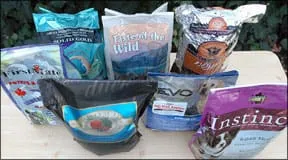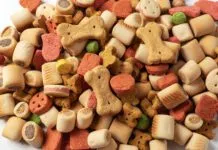Last month’s issue contained our annual review of dry dog foods, but with an exception from our usual format: This year, we decided to break out grain-free dry dog foods from the increasingly populated and competitive pack of terrific kibbled products on the market. We did not review them in the February issue, but will discuss grain-free foods at length here.
In 2005, Natura Pet Products was the first pet food company to manufacture and market a grain-free kibble, which was initially called Innova Evo (and is now called simply Evo). The success of the product, in the market and with many of the dogs fed the diet, sparked a proliferation of grain-free foods. We were able to find more than a dozen companies that currently offer one or more grain-free foods that meet our selection criteria.
Grain-free dry foods are still new enough that many dog owners wonder whether grain-free products are healthy for dogs – and how it’s even possible to make a dry dog food without grain.
Early pet food manufacturers used grain and grain by-products cast off by the human food manufacturing industry because they were readily available, relatively inexpensive, and functional. The choice wasn’t made because dogs needed grain, but because dogs could utilize them.

288
Dogs have no dietary requirement for grains, and are physically not well suited to harvest, chew, and digest them. Biologists who study wild canines argue vociferously about the importance of the grains that are consumed by the dog’s prey and are in turn taken in by the dog through consumption of his prey’s digestive tract – but most agree that the percentage of grain in the dog’s evolutionary diet is tiny.
The fact that the dog will eat grains and can derive benefits from them is less indicative of the suitability of dietary grain for canines and more of a testament to the dog’s long evolutionary history of eating anything and benefiting from it.
Plus, laboratory studies have proven that dogs have no dietary requirement for carbohydrates whatsoever; dogs can survive and thrive on diets containing only animal protein and fat.
The last – but not least – impetus for creating grain-free dog foods is the fact that some dogs are intolerant of or allergic to cereal grains. For these animals, grain-free foods often produce amazing results, as chronic symptoms of intolerance or allergy go away, and the dogs begin to thrive – perhaps for the first time in their lives.
Features of grain-free foods
When manufacturing grain-free kibble, whether baked, extruded, or dehydrated, most pet food companies replace grains with other carbohydrate sources; “grain-free” does not mean “carb-free.” To calculate the percentage of carbohydrates in a food, start with 100, and subtract the percentages of protein, fat, moisture, and ash. The remainder is the carbohydrate content.
The role that carbohydrates play in grain-free dry dog foods varies quite a bit. Some companies have produced foods that are very high in protein and fat, with low levels of carbohydrates. Others have taken a more moderate approach, creating products that are higher in carbohydrates, and with protein and fat levels that more closely resemble the levels found in conventional, grain-filled dry dog foods. A dog owner who is considering a grain-free food has to look at the following to determine which of the products would be most appropriate for her dog:
Amount of protein. High-protein diets are generally suggested for dogs with high-stress, high-activity lifestyles. Recent studies have suggested that a high-protein, low-carbohydrate diet helps fat dogs lose weight more efficiently than higher-carb diets that contain fewer calories. Diets with more moderate levels of high-quality protein are suggested for dogs with kidney disease.
Amount of fat. Some of these foods contain very high levels of fat. High-fat foods are most appropriate for hard-working dogs, dogs in extremely cold environments, breeding animals, dogs with cancer (who benefit from low-carbohydrate diets), and “hard keepers” – dogs who are chronically thin. High-fat diets are not appropriate for overweight dogs.
Amount of carbohydrates. If an owner is trying to feed a moderate protein, low-fat food, the diet will necessarily contain higher levels of carbs. This is a perfectly fine formula for many dogs. Just keep in mind that high-carb diets cause blood sugar fluctuations and insulin resistance – bad for dogs with or prone to diabetes. And dogs with cancer should eat high-fat, low- or no-carb diets (canine cancer cells utilize carbohydrates for growth).
Calcium and phosphorus levels.Calories. Some grain-free diets are very calorie-dense. Large- and giant-breed puppies, in particular, should not be fed high-calorie diets. And portion control is critical when feeding a high-calorie diet to a dog of any age.
Choices
On the following pages, we’ve highlighted some grain-free dry dog foods that meet our selection criteria for a top-quality food. On pages 16-17, we have identified 12 pet food makers with top-quality grain-free offerings, and we’ve highlighted the ingredients of one food from each company. The foods are presented in alphabetical order of their makers.
On pages 18-19, we delve deeper into the nutrient content of each highlighted food, including the amounts of protein, fat, carbs, calcium, and phosphorus (as well as other nutrients, as you’ll see).
Though each of these products meets our selection criteria, as we have just explained, only you can select the grain-free food that’s appropriate for your dog, using the nutrient values on our charts.
Keep in mind that these foods are not perfect for every dog; some dogs do better on a diet that contains grain!
An In-Depth Look at Typical Nutrient Levels in Commerical Dog Foods
On the previous pages and above, we’ve highlighted grain-free foods from 12 companies. Given a smaller field of foods than we feature in our review of conventional dry dog foods (which appears in each February’s issue), and given the fact that these companies have taken such disparate approaches to formulating their grain-free products, we decided that now would be a perfect time to discuss the variations in nutrient levels found in pet foods.
As we discussed in detail in “Take it With a Block of Salt,” (February 2007), it comes as a surprise to many dog owners that foods that are labeled as “complete and balanced” can actually contain a wide range of nutrient levels. While they probably contain at least a minimum of nutrients your dog needs, various “complete and balanced” foods do not provide equal amounts of essential nutrients!
On the following pages, we’ve charted the nutrient levels contained in each of the products highlighted on the previous pages. Take a look at how different they are – and let this information guide your selection of a product that’s most appropriate for your dog.
Why these nutrients?
In order to sell its products as “complete and balanced” for dogs, pet food makers have to ensure that the products meet certain requirements. The first way they can accomplish this is to formulate the candidate product so that the nutrients it contains fall within parameters developed by a quasi-governmental industry group, the Association of American Feed Control Officials (AAFCO).
AAFCO is not an enforcement or regulatory agency. Rather, it is comprised of feed control officials from each state, who get together to research, discuss, and develop model feed control policies (which are generally adopted, with some exceptions, by the individual states).
Over the decades, AAFCO members have mined facts and conclusions from nutritional studies conducted by industry and university researchers. Their goal has been the ongoing development and refinement of a set of recommendations: the AAFCO Dog and Cat Food Nutrient Profiles. The profiles include values for each of the nutrients currently understood to be essential for maintaining dogs or cats. For most of the nutrients, only a minimum value is offered; maximum “safe” values are known for only a small number of nutrients (mostly minerals, as well as vitamins A, D, and E).
The AAFCO Dog Food Nutrient Profiles include values for the following nutrients:
Crude protein, as well as the 10 amino acids known to be essential for maintaining canine health. (Many studies suggest that dogs would benefit from the addition of a minimum requirement for taurine, but this is still controversial among nutrition experts. Many dog food makers add taurine to their products anyway.)
Crude fat, as well as linoleic acid, an Omega 6 fatty acid.
Twelve minerals, including the two most important ones – calcium and phosphorus – which must be present in a specified range of ratios to each other.
Eleven vitamins. (A case can be made for the need to add minimum levels of vitamin K and biotin to the AAFCO profiles. Again, this is still controversial. Many dog food makers add vitamin K and/or biotin to their products.)
The AAFCO nutrient profiles (and our chart on the following pages) are expressed on what’s called a “dry matter” (DM) basis, making it possible to accurately compare foods that contain varying amounts of moisture.
Most pet food labels express their contents on an “as fed” basis, which includes the moisture present in the food. To convert an “as fed” value from the label of a dog food bag, divide the value listed by the percentage of the food that is not moisture. For example, say a label reports that a food contains 28% protein and 10% moisture. Divide 28 by 90 (the percentage of the food that is not moisture) and you get 31 – the percentage of protein in the food on a DM basis.
Other paths to adequacy
A company can also make a claim of nutritional adequacy for its candidate product based on feeding trials of the food that are conducted according to AAFCO protocols. In this case, the label will reference this, not the nutrient levels of the food.
Be aware that foods that have met the “feeding trials” standard may not meet all of the AAFCO nutrient profiles, and that foods that met the “nutrient levels” standard were not required to pass a feeding trial.
Try not to think about the third method of achieving a “complete and balanced” status. It won’t be hard, because you won’t see any mention of it on a product label. Referred to as the “family member” rule, it allows a manufacturer to use the “feeding trial” claim if the maker can demonstrate that a new product bears a “nutritional similarity” to one of its products that has already passed a feeding trial.
For each of the foods we’ve highlighted as “top grain-free dry dog foods,” we’ve charted the values (right) for each of the nutrients in the AAFCO profiles. We’ve noted at the bottom of the columns which foods met the “complete and balanced” nutritional adequacy requirements via the “nutrient levels” standard, and which met the “feeding trials” standard. You may notice that when you see values that lie outside (or close to the edges of) the AAFCO profiles, you’re almost always looking at a food that met the feeding trials standard.

288
By the way, we gathered the data for this table from the food makers themselves. Any food company ought to be able to produce this information to interested consumers in a snap, though we were dismayed to discover that some companies seemed to have trouble fulfilling our request. This is troubling, because their foods should be frequently tested to make sure their formulas are consistently producing the intended nutrient levels.
In contrast, we hugely appreciate and applaud companies like Natura Pet Products (maker of Evo), which keeps the complete typical nutrient analysis for each of its foods published on its website.
Why switching foods is a good idea
We’ve always found it fascinating that many otherwise knowledgeable dog owners and industry professionals (including veterinarians and long-time breeders) are unaware of the fact that different “complete and balanced” dog foods may display widely divergent amounts of the nutrients that are essential for their pet’s health.
Most foods have some nutrient levels that are relatively low and others that may be a bit high. Imagine that a dog is given a lifetime diet that is a bit low in some nutrients and a bit high in others. Over time, fed a diet solely comprised of that food, the dog’s body will become a figurative model of those nutrient levels, for better or worse. This is exactly why humans are told to eat a variety of healthy foods – to prevent this very scenario! Now, why would such a feeding plan make sense for canines, but not humans? It doesn’t!
We consider all of the foods mentioned here to be of very high quality – but we wouldn’t want a dog to eat only one of any of these (or any other) food for the rest of his life!








